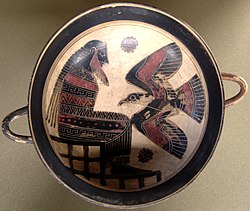Spartiates
| Sparta |
 Zeus on his throne with his eagle This article is part of the series: |
|
Great Rhetra Laws of Lycurgus Politeia |
|---|
|
List of Kings of Sparta Gerousia Ephorate Apella of the Damos Spartiates Perioeci Helots Agoge Syssitia |
|
Spartan army • Other Greek city-states • |
This article is part of the series:
Spartan Constitution
The Spartiates (Greek: Σπαρτιάται, "Spartans") or Homoioi (Greek: Ὅμοιοι, "those who are alike"; sing. homoios) were the males of Sparta known to the Spartans as "peers" or "men of equal status". From a young age, male Spartiates were trained for battle and put through gruelling challenges intended to craft them into fearless warriors. In battle, they had the reputation of being the best soldiers in Greece, and the strength of Sparta's hoplite forces let the city become the dominant state in Greece throughout much of the Classical period. Other city-states were reluctant to attack Sparta even though it could muster a force of only about 8000 Spartiates during the zenith of its dominance, such was the reputation of its soldiers.
Spartan society in the classical period was rigidly divided into several castes, each with assigned duties and privileges. The smallest of these, with the most power and freedom, was the Spartiate elite. Spartiates were exempt from manual labor, and controlled the government of the state. Spartiate men were expected to prepare constantly for military conflict. Below the Spartiates were the perioikoi, literally "dwellers around," inhabitants of outlying towns who carried out most of the trade and commerce of the city, since Spartiates were forbidden from engaging in commercial activity. Further down the ladder were the helots, enslaved populations tied to the land and over whom the Spartan state claimed ownership. In the late 5th century BC and later, a new class, the neodamodeis (lit. 'new' damos dwellers), arose. It seems to have been composed of liberated helots. Also, there were the hypomeiones (lit. inferiors), men who were probably, although not certainly, Spartiates who had lost social rank.
According to classical accounts, the Spartan constitution was the product of a great lawgiver, Lycurgus. He was said to have written the Spartan constitution late in the Archaic period, most likely in the 770s BC. It is impossible to determine whether Lycurgus was an actual historical figure. It is clear, however, that at some point in the late Archaic period the model of Spartan society was changed from a monarchical system to an for the elite warrior class. This change is likely to have been in some way related to the change from Dark age warfare, in which nobles were the dominant force, to the hoplite warfare of the classical period. Around the time of this change in system, Sparta embarked on the conquest of the neighboring state of Messenia. This acquisition of a large piece of territory and a large conquered population seems to have both provided the basis for the system of helotage and required the existence of a large military force to keep the potentially rebellious Messenians under control. The Spartiates thus became a permanently armed master class, living off the labour of the helots and preventing rebellion through constant struggle.
...
Wikipedia
